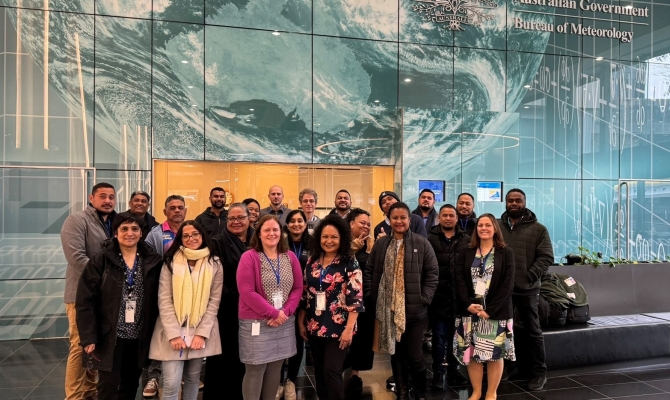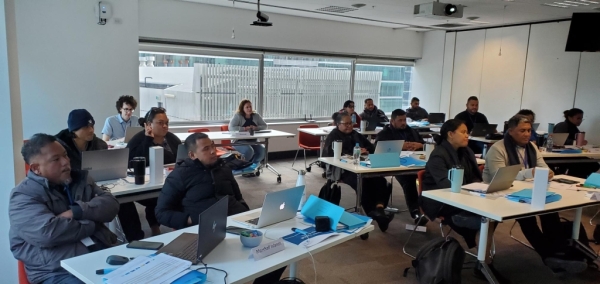
15 July 2024, Melbourne, Australia – A training to develop the skills of Climate and Ocean Officers from the Pacific on the science of the Ocean and Atmosphere and how its modelled using Australian Community Climate and Earth-System Simulator – Seasonal (ACCESS-S) model will go a long way to improve climate early warning systems and safeguard lives in Pacific communities.
The second attachment training workshop on Climate, Oceans including ACCESS-S for representatives from National Meteorological and Hydrological Services (NHMS) from the Cook Islands, Marshall Islands, Niue, Palau, Tuvalu, and Tonga is held in Melbourne Australia from15-26 July. It is attended by 12 participants from the six countries who have the opportunity to learn more about the ACCESS-S model, understand model outputs in terms of maps and how they can utilise it for climate seasonal prediction in their respective countries.
Funded by Green Climate Fund (GCF) and the United Nations Environment Programme (UNEP), and implemented by the Bureau of Meteorology (BOM), the Secretariat of the Pacific Regional Environment Programme (SPREP), through the COSPPac and ClimSA projects supported the workshop by providing technical resource personnel.
During the opening of the training, the head of the climate service at the Australian Bureau of Meteorology, Mr Karl Braganza, reminded that the continuous uptake of climate science during a time of rapid change in technology including our changing climate is very important for NHMS in the Pacific to continue provide quality services to our people.
“The Bureau is honored to continue to provide these types of training to the Pacific NMHS to further develop the skills of climate and ocean officers to provide early warning services for early actions at all levels,” said Mr Braganza. “This was evident since the involvement of Australian Government through the Pacific Islands Climate Prediction project (PICPP) in early 2004 then continued with COSPPac programme which is now a flagship programme in the region by the Australian Government.”
The first week of the training focused on areas such as Basic Climate and Statistics introduction, Drought, Satellite monitoring and ACCESS-S model, Advanced Statistics, Tropical Cyclone, and Ocean and Climate Outlook Forum (OCOF). The emphasis was placed on the importance of climate drivers such as El Nino Southern Oscillation (ENSO), Madden Julian Oscillation, Intertropical Convergence Zone (ITCZ) and the South Pacific Convergence Zone (SPCZ) affecting the Pacific region.

“The understanding of these climate drivers will enable them to have a broader understanding of these systems, coupled with weather related events such as trough of low-pressure systems, frontal systems, cyclones, high pressure systems, and trades wind can influence sub-seasonal and season outlook for these countries,” said SPREP’s Senior Climatologist, Mr Philip Malsale, who facilitated the 202nd session of the Ocean and Climate Outlook Forum.
“With our changing climate, the behaviour of our climate system is getting very complex. For example, during our last wet season (November 2023 to April 2024), an El Nino phenomenon was established.
“However, the impacts are not El Nino like over most places across the region, like Fiji, Tonga, to name a few. Climate officers were reminded that they are the experts in-country, and they need to have a clear process for delivering their seasonal outlook. It is important for them to develop clear, concise and user-friendly messaging so that users can make sound decisions.”
The second week of the training is focussing on Advanced Ocean dynamics and ocean portal activities, model skill, and development of products.
SPREP is collaborating with Australia Bureau of Meteorology and Pacific Community through the UNEP CIS-Pac 5 project to achieve SPREP’s Strategic regional goal 1.3 that Pacific people benefit from strengthened resilience to climate change through enhance National Meteorological and Hydrological Services capacity in weather forecasting, early warning systems, long-term projections, and improved climate services to support Members’ decision making and coordination through the Pacific Meteorological Council.
The training enhances the capacity of the six NMHS on climate science and how they can utilise the available tools to enable them improve their climate early warning system for decision making.
Regional Climate Centre Coordinator Climsa Project, Mr Terry Atalifo, also provided support and raised awareness on the services provided by the Pacific Regional Climate Centre – Network.